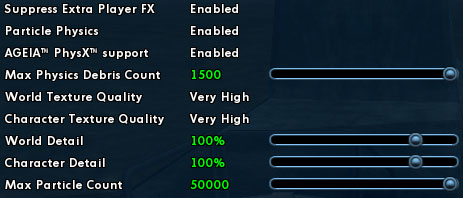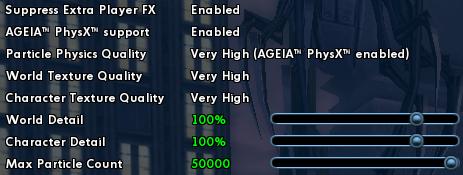PhysX Performance Update: City of Villains
by Ryan Smith on September 7, 2006 6:00 AM EST- Posted in
- GPUs
The last time we took a look at physics performance under City of Villains utilizing a PhysX card, the code was still in beta, and the results for the PhysX card were lackluster at best. What we found was that while utilizing a PhysX card did indeed enable CoV to generate a good deal of extra eye-candy, the cost came at an immense performance drop, especially to minimum framerates. At the time, AGEIA had promised that performance under CoV would improve between then and when the improvements were actually put into the Issue 7 patch. That patch has since shipped, and we are back to take a look at just what the PhysX card is capable of doing given more refined code.
Since the beta version of Issue 7 was in testing, Cryptic has also made several changes to CoV to better allow benchmarking, as previously FRAPS was the only way to do a repeatable test using higher physics settings. The CoV's benchmark mode now properly renders additional physics based on the game's settings, allowing for more controlled testing and more importantly testing against the live server where we can no longer copy characters. Also, the highest physics mode, previously only allowed with PhysX hardware installed, now can run completely under software, giving true apples-to-apples testing where all physics effects are the same.


This later point is particularly important, since AGEIA was able to confirm a few earlier theories we had on the game. In the highest quality mode (various physics modes have replaced the items slider), both the hardware and software physics engines end up doing the same physics routines with the same precise formulas. Meanwhile, in any of the lower quality modes the software engine is allowed to make approximations in return for the faster calculations, and at the lowest quality settings the software mode renders fewer overall effects. We'll look at how the various settings affect the performance and visual quality under CoV, so keep in mind that only the maximum quality mode is identical for both software and hardware physics.
Dual core performance is also something that has seen some changes since the Issue 7 beta, as the game is now capable of doing physics calculations on a separate core. As we'll see in a second, the game benefits tremendously from a second core, which may not be in AGEIA's best interests.
What does all of this mean for physics performance then under CoV? Let's take a look.
Since the beta version of Issue 7 was in testing, Cryptic has also made several changes to CoV to better allow benchmarking, as previously FRAPS was the only way to do a repeatable test using higher physics settings. The CoV's benchmark mode now properly renders additional physics based on the game's settings, allowing for more controlled testing and more importantly testing against the live server where we can no longer copy characters. Also, the highest physics mode, previously only allowed with PhysX hardware installed, now can run completely under software, giving true apples-to-apples testing where all physics effects are the same.


This later point is particularly important, since AGEIA was able to confirm a few earlier theories we had on the game. In the highest quality mode (various physics modes have replaced the items slider), both the hardware and software physics engines end up doing the same physics routines with the same precise formulas. Meanwhile, in any of the lower quality modes the software engine is allowed to make approximations in return for the faster calculations, and at the lowest quality settings the software mode renders fewer overall effects. We'll look at how the various settings affect the performance and visual quality under CoV, so keep in mind that only the maximum quality mode is identical for both software and hardware physics.
Dual core performance is also something that has seen some changes since the Issue 7 beta, as the game is now capable of doing physics calculations on a separate core. As we'll see in a second, the game benefits tremendously from a second core, which may not be in AGEIA's best interests.
What does all of this mean for physics performance then under CoV? Let's take a look.










31 Comments
View All Comments
stepz - Thursday, September 7, 2006 - link
I don't really care for the PPU, but it would be really interesting to see what quad-cores or AMD's 4x4 would do with city of villains. Can the PPU keep its ground and does the game scale to 4 cores. You can emulate the 4x4 platform with 2xx Opterons.Ryan Smith - Thursday, September 7, 2006 - link
CoV only has 2 worker threads(basically broken up in to a renderer and a physics thread), so more cores wouldn't directly help.PrinceGaz - Friday, September 8, 2006 - link
That's a shame because I was wondering the same thing about quad-core processors and whether they can match or even exceed the throughput of the PhysX card. After all quad-core processors should be available this time next year and will be commonplace by 2008.The application should ideally branch off as many physics-threads as there are cores available, so on a dual-core system I would like to see two physics threads (rather than just one) in addition to the main game thread, thus ensuring all spare CPU power can be used for physics work. Having only two threads in total each performing different types of work will usually result in one of the cores being partially idle.
I personally see the PhysX card as a short-lived product because CPU power is set to rise dramatically in coming years now the focus is on ever more cores (doubling every couple of years or so); there'll be so much CPU power available to easily multi-threaded tasks like physics that there will be no need for a dedicated physics processor chip in any form.
Gilhooley - Thursday, September 7, 2006 - link
It would be nice with more of a "real world" test. Today when people are playing games online, they usally have: the game, teamspeak, game scanner, browsers for forum game/clan info and perhaps a torrent client running.Myself I noticed a huge diffence in min fps with a dualcore vs single just with game and teamspeak - just as you tested in a earlier article. So, the question is, witch HW takes the biggest hit in a "real world" situation?
bespoke - Thursday, September 7, 2006 - link
Maybe if DirectX 10 has a physics API that the AGEIA's PhysX card can hook into, we'll see games that can use the card well. Otherwise no one is going to buy a card that only works for a few games that go out of their way to support a 3rd party API that results in a small frame rate increase.poohbear - Thursday, September 7, 2006 - link
hhhmmhmmmmmm should i upgrade to a new x1900xt w/ 256mb ram for $280 or buy ageia's ppu for $280? really tough decision. wtf does ageia think they are selling @ that price point?DigitalFreak - Thursday, September 7, 2006 - link
These companies always target people with more money than sense.Kwincy - Thursday, September 7, 2006 - link
I don't think they're targeting people with more money than sense, it's just like all new products introduced, they're recouping all their R&D costs to bring the product to the market. Once they either do that, or people stop buying or don't buy this PPU at all, you'll see prices go down. It always happens, unless a competing product comes out for a better value.yyrkoon - Thursday, September 7, 2006 - link
Going from no PPU, to using one seems to be about the difference possible of switching from onboard audio, to a dedicated audio card (not very much of a difference). Less than 6 FPS min on a low end (Conroe ?) CPU, just doesnt seem to be worth the additional $250.Now, since there is no standards for PPUs, I think this makes it even worse. I bet GPU manufactuers will end up winning the race in this arena.
Christobevii3 - Thursday, September 7, 2006 - link
If they could make the card accelerate other things too it would be cool. Imagine if like batch conversions in photoshop could use some of the processing power...